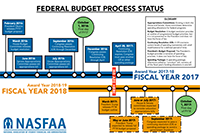Deliberations on Final Spending Levels for FY 2017 May Wrap Up This Week, Year-Round Pell in the Mix
By Stephen Payne, Policy & Federal Relations Staff
Congress returns to Washington this week following a two-week recess with only a few days to come to an agreement to fund the federal government for the remainder of the fiscal year and to avoid a government shutdown. A continuing resolution (CR) to fund the government, passed in December, will expire this Friday, April 28. This will be the first budget negotiation with the Trump administration at the table.
The deliberations this week are focused on spending levels for federal fiscal year (FY) 2017, which funds student aid programs for award year 2017-18; however, FY 2017 began on October 1, 2016, meaning Congress has yet to finalize spending for a fiscal year over halfway complete.
Making the process all the more confusing, President Trump outlined his FY 2018 (affecting the next award year, 2018-19) budget priorities last month, which included eliminating the Federal Supplemental Educational Opportunity Grant (FSEOG) Program and a “significant” cut to Federal Work-Study (FWS), though no specific percentage cut was provided. October 1, 2017 will mark the beginning of FY 2018.

With two federal budget and funding processes underway at once, NASFAA created a timeline to visually illustrate the current status of the budget process.
This week Congress will need to reach agreement on spending levels for FY 2017, perhaps through a large spending bill, called an “omnibus” bill, that includes funding for all federal programs. At this point, NASFAA does not expect any sort of significant funding cuts—or increases—to the student aid programs. Congress also has the option to pass a short-term CR that could yet again extend the deadline for a government shutdown until an agreement is reached.
Higher education advocates are closely watching the final spending agreement for the potential restoration of year-round Pell, or “summer Pell,” which would provide access to a second scheduled Pell Grant award in an award year. Restoring year-round Pell appears to be a leading bipartisan higher education policy proposal with Speaker of the House Paul Ryan, Secretary of Education Betsy DeVos, and other Democrats and Republicans publicly supportive. Last summer, the Senate Appropriations Committee passed an education spending bill out of committee with a bipartisan 29-1 vote that included restoration of year-round Pell with language that will avert many of the implementation challenges in the last short-lived iteration of summer Pell. However, the House education spending bill did not include year-round Pell whatsoever. In October, NASFAA sent a letter to congressional leaders outlining financial aid office priorities for any potential restoration of year-round Pell.
In addition, both the Senate and House education spending bills removed funding for the Pell Grant Program. The Senate pulled $1.2 billion from the Pell Grant reserve, while the House simply allocated $1.3 billion less to Pell. Each creates a troubling precedent of using reserves in the Pell Grant Program to fund other priorities, but the House proposal to fund Pell at a lower level could set a dangerous trend for future years. In January, the Congressional Budget Office reported the Pell Grant Program has amassed $10.6 billion in its reserve fund.
Several other contentious policy issues, including border wall funding, language blocking federal funds from “sanctuary cities,” additional defense spending, former President Barack Obama's health care law subsidies, and coal miner benefits, could stall any agreement on a spending bill, which could then lead to a short-term CR to buy some time to negotiate or result in a government shutdown.
As covered in Today’s News in 2015, a government shutdown would not likely result in a significant disruption to federal student aid; however, continued delays in finalizing federal spending for FY 2017 are slowing final award year (AY) 2017-2018 campus-based aid allocations. Institutions should not expect final allocations until FY 2017 is settled by Congress.
NASFAA will continue to monitor spending negotiations over the next few days with continued updates in Today’s News. To learn more about the budget process, visit NASFAA’s Budget and Appropriations Page for background information and a news archive.
Publication Date: 4/24/2017






Georgeann L | 4/25/2017 11:41:28 AM
Eliminating the FSEOG and FCWS programs for our 2 year non-profit school will be devastating. Many of our students use the FSEOG program to supplement their Pell Grant award so they do not need to apply for student loans using the additional grant funds for book purchases.
Our offices and departments rely heavily on our college work study students to complete many jobs and tasks to supplement our work loads. Without work study students we will need to look elsewhere for workers.
If and when these programs are cut I can foresee students applying for more student loan monies to fill in the gap from the loss of their FSEOG and/or FCWS funds. That will be a sad day for all.
You must be logged in to comment on this page.